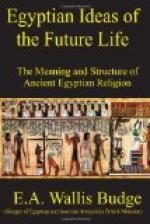With these words Chapter CXXV comes to an end. We have seen how the deceased has passed through the ordeal of the judgment, and how the scribes provided him with hymns and prayers, and with the words of a confession with a view of facilitating his passage through the dread Hall of the Ma[=a]ti goddesses. Unfortunately the answer which the god Osiris may be supposed to have made to his son Horus in respect of the deceased is not recorded, but there is no doubt that the Egyptian assumed that it would be favourable to him, and that permission would be accorded him to enter into each and every portion of the underworld, and to partake of all the delights which the beatified enjoyed under the rule of R[=a] and Osiris.
CHAPTER V.
THE RESURRECTION AND IMMORTALITY.
In perusing the literature of the ancient Egyptians one of the first things which forces itself upon the mind of the reader is the frequency of allusions to the future life or to things which appertain thereto. The writers of the various religious and other works, belonging to all periods of Egyptian history, which have come down to us, tacitly assume throughout that those who once have lived in this world have “renewed” their life in that which is beyond the grave, and that they still live and will live until time shall be no more. The Egyptian belief in the existence of Almighty God is old, so old that we must seek for its beginnings in pre-dynastic times; but the belief in a future life is very much older, and its beginnings must be as old, at least, as the oldest human remains which have been found in Egypt. To attempt to measure by years the remoteness of the period when these were committed to the earth, is futile, for no date that could be given them is likely to be even approximately correct, and they may as well date from B.C. 12,000 as from B.C. 8000. Of one fact, however, we may be quite certain; that is to say, that the oldest human remains that have been found in Egypt bear upon them traces of the use of bitumen, which proves that the Egyptians at the very beginning of their stay in the valley of the Nile made some attempt to preserve their dead by means of mummification. [Footnote: See J. de Morgan, Ethnographie Prehistorique, Paris, 1897, p. 189.] If they were, as many think, invaders who had made their way across Arabia and the Red Sea and the eastern desert of the Nile, they may have brought the idea and habit of preserving their dead with them, or they may have adopted, in a modified form, some practice in use among the aboriginal inhabitants whom they found on their arrival in Egypt; in either case the fact that they attempted to preserve their dead by the use of substances which would arrest decay is certain, and in a degree their attempt has succeeded.




